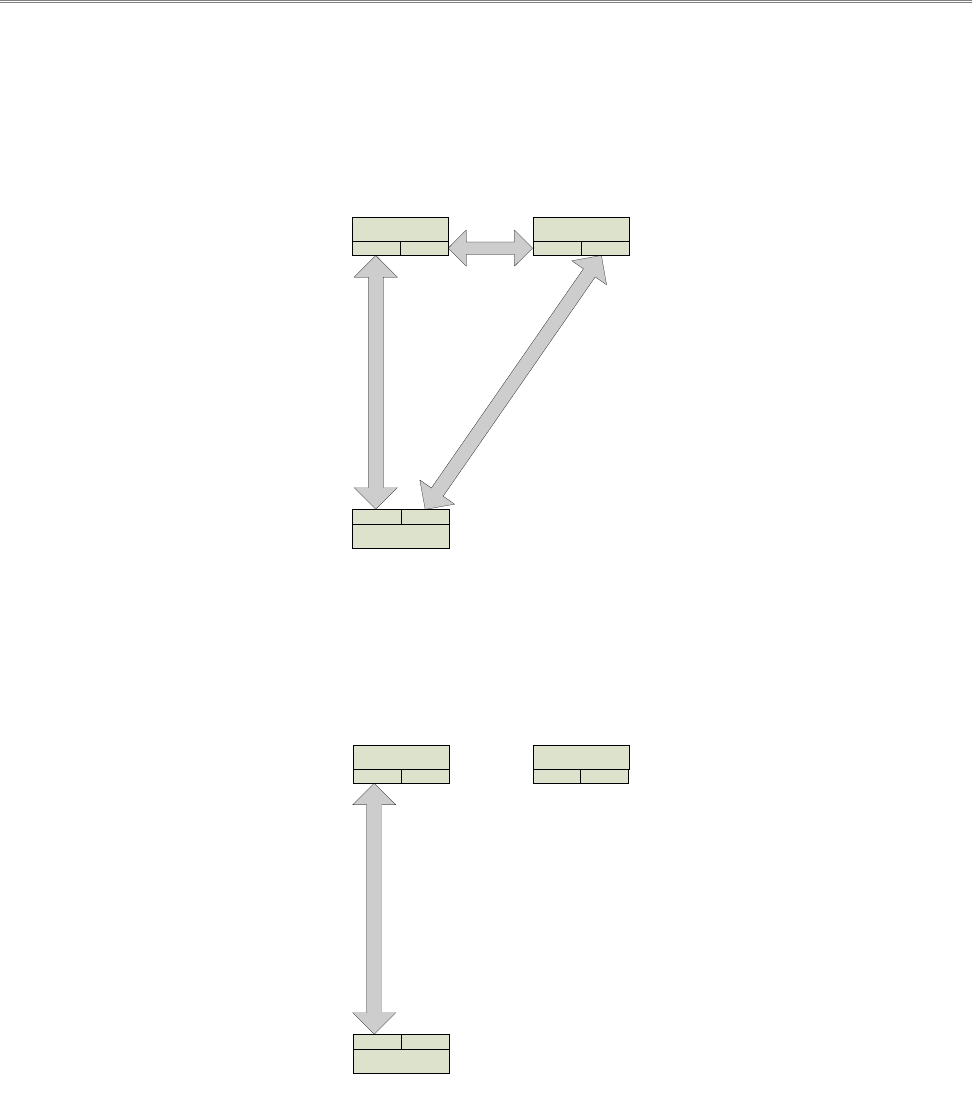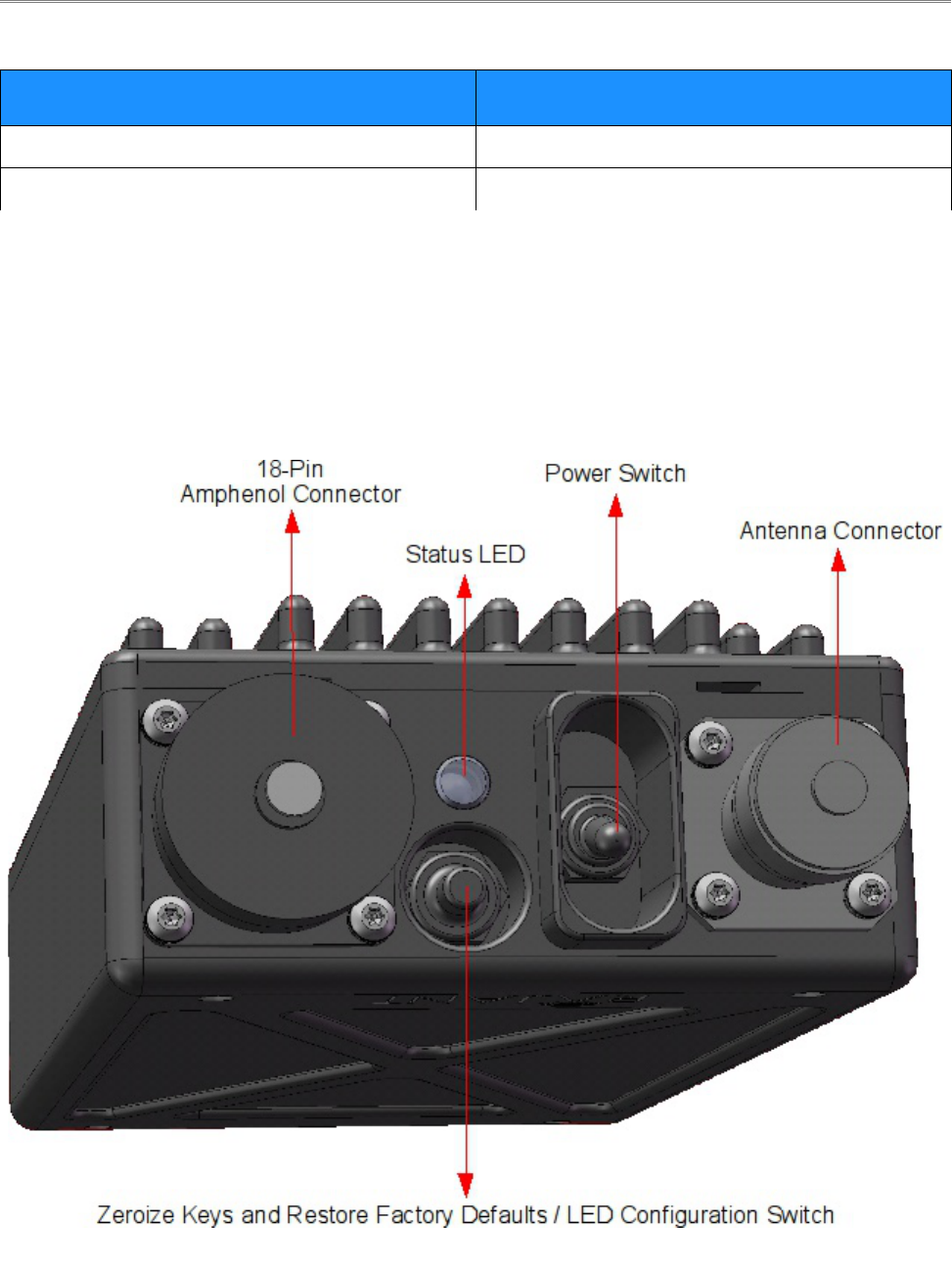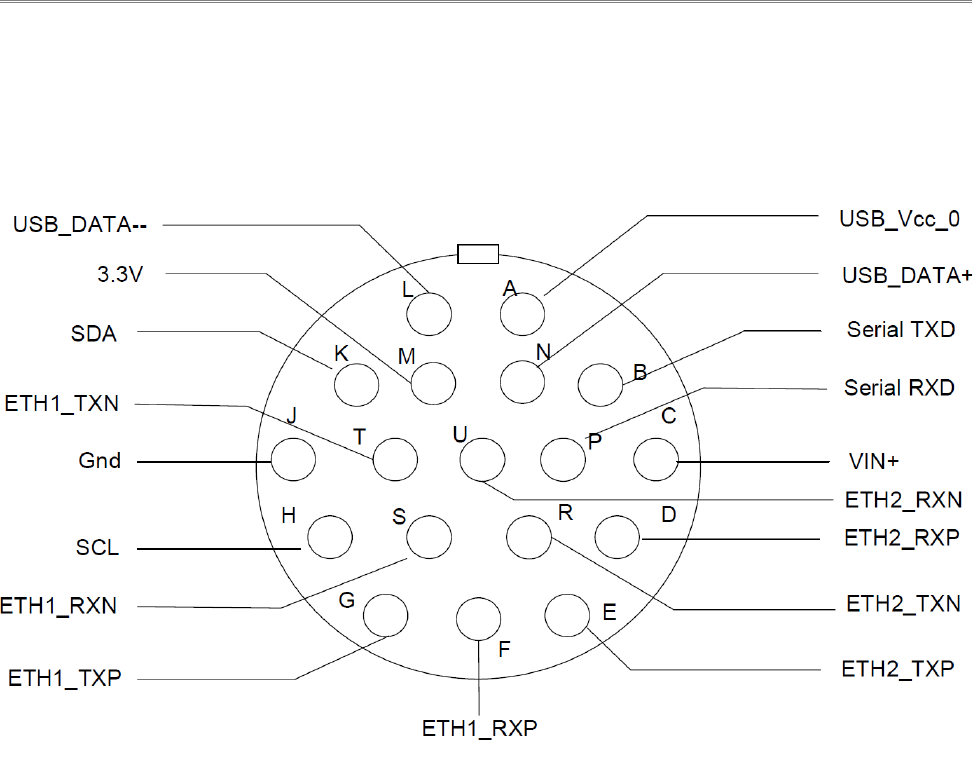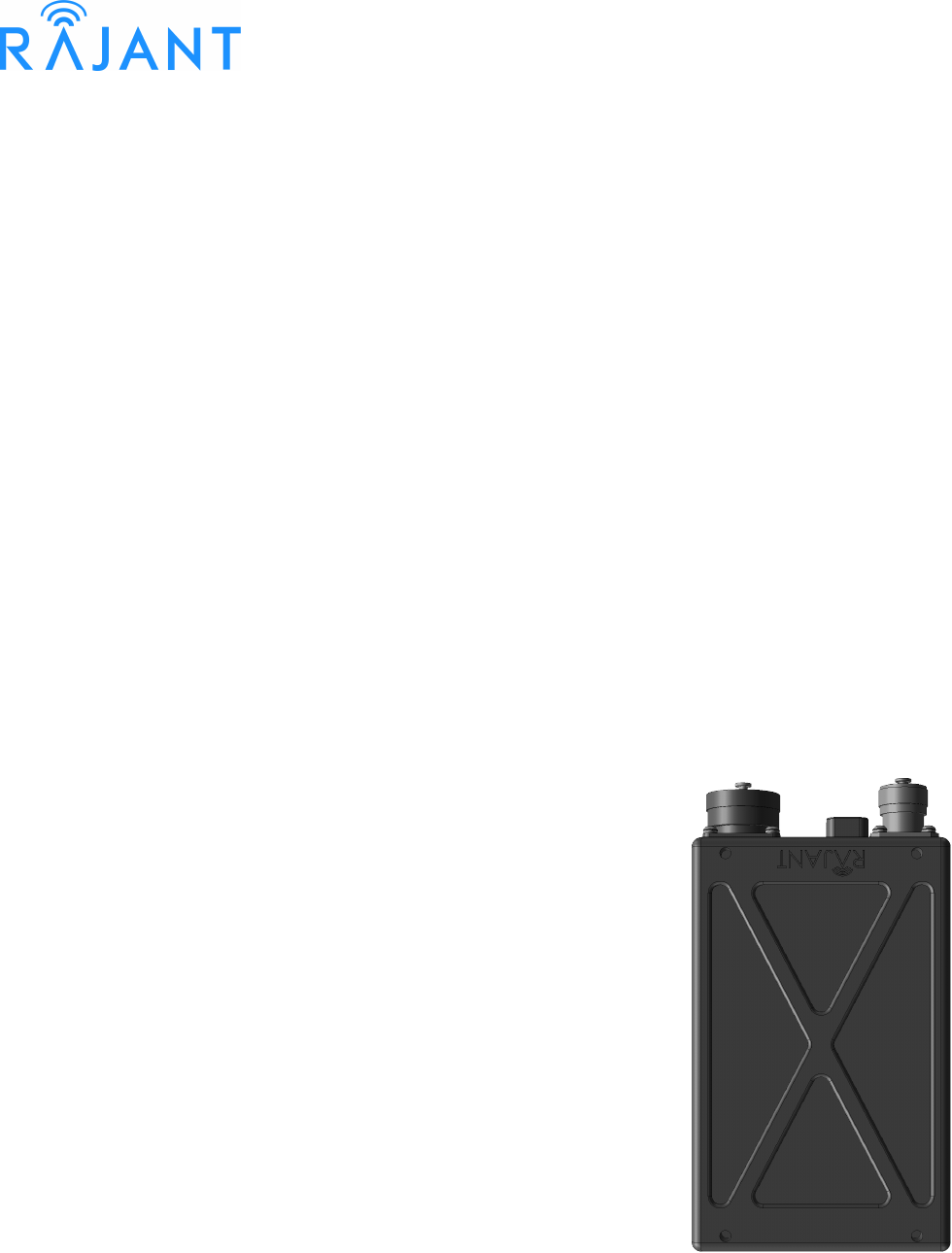Rajant ME3-24 Long Range Mobile Broadband Communications Device User Manual
Rajant Corporation Long Range Mobile Broadband Communications Device
Rajant >
User Manual
FCC and IC Statements
This equipment has been tested and found to comply with the limits for a Class A digital device,
pursuant to Part 15 of the FCC Rules. These limits are designed to provide reasonable protection
against harmful interference when the device is operated in a commercial environment. This device
generates, uses, and can radiate radio frequency energy and, if not installed and used in accordance
with this instruction manual, may cause harmful interference to radio communications. Operation of
this device in a residential area is likely to cause harmful interference in which case the user will be
required to correct the interference at their own expense.
This Class A digital apparatus complies with Canadian ICES-003 and RSS-210 rules.
Cet appareil numérique de la classe A est conforme à la norme NMB-003 et CNR-210 du Canada.
WARNING: To satisfy FCC RF exposure requirements a minimum safe distance of 20 cm must be
maintained between this device and all persons while the device is operating.
CAUTION: To reduce potential radio interference to other users, the antenna type and its gain
should be chosen so that the equivalent isotropically radiated power (EIRP) is not more than that
permitted for successful communication.
CAUTION: Changes or modifications not expressly approved by Rajant Corp. could void the user's
authority to operate the equipment.
Copyright Statement
You may use the software provided with the products only on personal computers owned by the
purchasing individual or entity, and may not use, load, or run any such software on any network or in
any type of service bureau, time-sharing operation, or non-purchasing individual or entity's
equipment.
BCAdmin and BCAPI are trademarks; Rajant, the Rajant logo, BreadCrumb, Instamesh, BC|
Commander, and Bring Your Network with You! are registered trademarks of Rajant Corp. in the
United States and certain other countries.
BreadCrumb® ME3 User Guide
Copyright © 2009–2010 Rajant Corp. All rights reserved.

Rajant Corporation BreadCrumb® ME3 User Guide
03-100116-001 Version: 1.02
Table of Contents
Preface....................................................................................................................................v
Purpose and Scope.............................................................................................................v
User Information..................................................................................................................v
Related Documentation.......................................................................................................v
1 Introduction.......................................................................................................................1
1.1 What is a BreadCrumb?...............................................................................................1
1.2 Mobility through Meshing.............................................................................................2
1.2.1 Mesh – A Definition...............................................................................................2
1.2.2 BreadCrumbs Mesh by Channel and ESSID.......................................................2
1.3 Description of BreadCrumb ME3.................................................................................3
1.3.1 Radio.....................................................................................................................4
1.3.2 Enclosure..............................................................................................................5
1.3.3 18-Pin Amphenol Connector.................................................................................6
1.3.3.1 Power............................................................................................................6
1.3.3.2 Ethernet.........................................................................................................6
1.3.3.3 USB...............................................................................................................7
1.3.4 Antenna Connector...............................................................................................7
1.3.5 Status LED............................................................................................................7
1.3.6 Zeroize Keys and Restore Factory Defaults / LED Configuration Switch............8
1.3.6.1 Zeroize Keys and Restore Factory Defaults.................................................8
1.3.6.2 LED Configuration.........................................................................................9
1.3.7 Internal Battery...................................................................................................10
2 Using BC|Commander....................................................................................................11
3 Deploying the BreadCrumb Wireless Network............................................................13
3.1 Addressing.................................................................................................................13
3.1.1 BreadCrumb Device Addresses.........................................................................13
3.1.2 DHCP..................................................................................................................13
3.2 Channel Assignments................................................................................................13
3.3 Physical Placement and other Considerations..........................................................14
3.3.1 Line-of-Sight.......................................................................................................14
3.3.2 Distance..............................................................................................................14
3.3.3 Weather..............................................................................................................15
3.3.4 Interference.........................................................................................................15
3.3.5 Placement of BCWN Components.....................................................................15
3.4 Deployment Guidelines and Methodology.................................................................15
3.4.1 Deployment Guidelines......................................................................................16
3.4.2 Deployment Methodology...................................................................................16
4 BreadCrumb ME3 USB Firmware Upgrade...................................................................19
iii

BreadCrumb® ME3 User Guide Rajant Corporation
Version: 1.02 03-100116-001
5 Troubleshooting..............................................................................................................21
5.1 Sporadic Network Connectivity..................................................................................21
5.2 BreadCrumb Device Cannot Connect to BCWN.......................................................22
Appendix A: Error and Warning Codes..........................................................................A-1
List of Figures
Figure 1: All BreadCrumbs Use the Same ESSID.................................................................3
Figure 2: ESSID of BreadCrumb C Changes to "lonely.".......................................................3
Figure 3: BreadCrumb ME3 Enclosure Features...................................................................5
Figure 4: 18-Pin Amphenol Connector...................................................................................6
List of Tables
Table 1: ME3 Model versus Radio Frequency.......................................................................4
Table 2: 2.4 GHz Radio Channels and Frequencies..............................................................4
Table 3: 900 MHz Radio Channels and Frequencies............................................................5
Table 4: Status LED Color Codes..........................................................................................8
Table 5: Default and alternate display states of the Status LED............................................9
Table 6: Sporadic Network Connectivity Issues...................................................................21
Table 7: BreadCrumb to BCWN Connectivity Issues...........................................................22
iv

Rajant Corporation BreadCrumb® ME3 User Guide
03-100116-001 Version: 1.02
Preface
Purpose and Scope
This manual provides information and guidance to all personnel who are involved with and use
Rajant Corporation’s BreadCrumb ME3 product.
This manual begins with an introduction to the BreadCrumb Wireless Network (BCWN). It then
characterizes the features of the BreadCrumb ME3. Finally, it describes common deployment
scenarios and provides concise step-by-step instructions for each scenario.
User Information
The user of this manual is encouraged to submit comments and recommended changes to improve
this manual. Please send any comments or changes to support@rajant.com. Be sure to include the
version number of the manual you are using and please provide the page numbers related to your
comments wherever possible.
Related Documentation
For additional BreadCrumb ME3 information, refer to these documents:
•BC|Commander® User Guide: This document contains information on the BC|Commander
management application, which is used to configure BreadCrumbs before or during a
deployment.
•BreadCrumb® Video Guide
•BreadCrumb® VLAN Guide
•Troubleshooting Range User Guide
•RF Component Installation and Verification in BreadCrumb® Networks
v

Rajant Corporation BreadCrumb® ME3 User Guide
03-100116-001 Version: 1.02
1 Introduction
Rajant Corporation's (http://www.rajant.com) BreadCrumb ME3 utilizes the 802.11g wireless
networking standard to form a wireless mesh network. The network is mobile, self-integrating, self-
meshing, self-healing, full-duplex and secure. The focus is on flexibility, adaptability, and
simplicity.
The BreadCrumb Wireless Network (BCWN) is intended for rapid deployment of a broadband
wireless network into a situation or “hot zone.” The network can be deployed as a stand-alone
wireless network, or bridged to another network (such as the Internet) utilizing available reach-back
communication links (such as a DSL, cable, or satellite modem).
BreadCrumb ME3 provides high bandwidth applications to stream video, audio as well as data over
large distances. The network traffic can be secured by using different security features offered by
the BCWN. This makes the network optimal for tactical deployments as well as emergency
response situations since it offers robustness, stability and ease of setup in mission critical activities.
Note Throughout this document, unless otherwise stated, the terms Breadcrumb and ME3
are used to refer to Rajant BreadCrumb ME3.
1.1 What is a BreadCrumb?
A BreadCrumb is an IEEE 802.11 (Wi-Fi) and Ethernet compatible networking device which has the
capacity to connect to other BreadCrumbs or networking devices to form a BreadCrumb network. A
BreadCrumb is specifically designed for the following scenarios:
Temporary Wireless Networks
Networks that must be established quickly and with minimal effort for short-term use (e.g., a
network established to provide First Responder support at the site of a disaster).
Mobile Wireless Networks
Networks in which the network infrastructure itself is mobile, in addition to client devices (e.g., a
convoy viewing a video stream from a UAV).
Wireless Network Extension
Networks in which a wireless network must be quickly extended around or through obstacles that
block wireless communications (e.g., urban canyon networks, tunnels/caves, etc.)
Wired Network Extension
Networks in which two or more wired LANs at different locations must be connected wirelessly
(e.g., to securely connect combat service support computers with logistics bases)
Any Combination of the Above
Most BreadCrumb deployments include elements from more than one of the above scenarios.
1

BreadCrumb® ME3 User Guide Rajant Corporation
Version: 1.02 03-100116-001
In many cases, BreadCrumbs will perform all of these tasks as shipped with no configuration
necessary at all, providing an instant TAN (Tactical Area Network). Moreover, because
BreadCrumbs use industry-standard 802.11 communications, client devices such as laptops or
handheld computers require no special hardware, software, or configuration to access a BCWN.
1.2 Mobility through Meshing
The key component to a BCWN is a technique known as meshing. While this is generally handled
automatically by BreadCrumbs, complex deployment scenarios require a basic understanding of how
BreadCrumbs establish and maintain a mesh.
1.2.1 Mesh – A Definition
A mesh is a collection of network devices (in our case, BreadCrumbs), each of which is linked to one
or more other BreadCrumbs. Data can move between BreadCrumbs via these links, possibly passing
through several intermediate BreadCrumbs before arriving at its final destination.
The intelligence of a BCWN is in how it adapts rapidly to the creation or destruction of the links in
the mesh as devices are moved, switched OFF or ON, blocked by obstructions, interfered with by
other devices, or otherwise affected. This adaptation takes place automatically and immediately as
needed.
Note
Although all BreadCrumbs can be access points, most access points do not provide
mesh capability. Traditional access points simply allow wireless devices within
range to connect to a wired network; they do not extend range through other access
points.
1.2.2 BreadCrumbs Mesh by Channel and ESSID
Two BreadCrumbs establish a mesh link to each other when they share both a radio channel and an
ESSID. An ESSID is essentially a name for a wireless network. By default, BreadCrumb ME3 uses
the ESSID “breadcrumb54-v10.” Also by default, BreadCrumb ME3-09 model devices use channel
6, and BreadCrumb ME3-24 model devices use channel 11.
The following examples illustrate the use of channels and ESSIDs:
2

Rajant Corporation BreadCrumb® ME3 User Guide
03-100116-001 Version: 1.02
Example 1:
Suppose you have three BreadCrumbs, called A, B, and C. Each has two radios. BreadCrumb A’s
radios are on channels 1 and 8, B’s are on 8 and 11, and C’s are on 1 and 11. All three BreadCrumbs
are using the default ESSID of "breadcrumb54-v10." Assuming that all three BreadCrumbs are
within radio range of one another, the network will be connected, as shown below:
Example 2:
Now suppose that you change the ESSID of BreadCrumb C to "lonely". The network will adjust to
this change, resulting in the following configuration:
Note that BreadCrumb C can no longer communicate with A or B, and vice versa.
1.3 Description of BreadCrumb ME3
BreadCrumb ME3 is a portable, battery operated, wireless device deployable in almost any
environment. It is light in weight, offers one external antenna and a rechargeable battery, and is
designed to be completely mobile as worn by an individual.
3
Figure 1: All BreadCrumbs Use the Same ESSID.
CHANNEL 1
CHANNEL 11
CHANNEL 8
RADIO 2
BREADCRUMB B
RADIO 1
RADIO 1
BREADCRUMB C
RADIO 2RADIO 1
BREADCRUMB A
RADIO 2
Figure 2: ESSID of BreadCrumb C Changes to "lonely."
CHANNEL 8
RADIO 2
BREADCRUMB B
RADIO 1
RADIO 1
BREADCRUMB C
RADIO 2RADIO 2
BREADCRUMB A
RADIO 1

BreadCrumb® ME3 User Guide Rajant Corporation
Version: 1.02 03-100116-001
1.3.1 Radio
BreadCrumb ME3 comprises one 802.11g radio, which depending on the ME3 model, operates
either in the 900 MHz or the 2.4 GHz frequency band. The ME3 model versus radio frequency
options are listed in Table 1 below.
Table 1: ME3 Model versus Radio Frequency.
ME3 Model Radio Frequency
ME3-24 2.4 GHz
ME3-09 900 MHz
The two possible radios support the following channels and frequencies in the United States and
Canada (see Table 2 and Table 3):
Note
Not all channels are allowed for use everywhere around the world. Check with the
corresponding wireless spectrum regulatory body to determine the subset of
channels authorized for use in your country.
Table 2: 2.4 GHz Radio Channels and Frequencies.
Channel Number Center Frequency (MHz)
1
2412
2
2417
3
2422
4
2427
5
2432
6
2437
7
2442
8
2447
9
2452
10
2457
11
2462
The default channel for a 2.4 GHz BreadCrumb radio is 11 (2462 MHz).
4

Rajant Corporation BreadCrumb® ME3 User Guide
03-100116-001 Version: 1.02
Table 3: 900 MHz Radio Channels and Frequencies.
Channel Number Center Frequency (MHz)
5
912
6
917
The default channel for a 900 MHz BreadCrumb radio is 6 (917 MHz).
1.3.2 Enclosure
The ME3 enclosure has been designed to operate in extreme conditions with protection against
ingress of dust as well as protection against immersion in water. The enclosure dimensions are 176
mm x 95 mm x 48 mm (6.94” x 3.75” x 1.88”).
The external features of the enclosure are shown in Figure 3 below.
5
Figure 3: BreadCrumb ME3 Enclosure Features.

BreadCrumb® ME3 User Guide Rajant Corporation
Version: 1.02 03-100116-001
1.3.3 18-Pin Amphenol Connector
The majority of the signals and features of BreadCrumb ME3 can be accessed through the 18-pin
Amphenol connector on the enclosure (see Figure 4). The most important of these interfaces are
external power, Ethernet, and USB, which are described in more detail in the following sections.
The 18-pin Amphenol connector interfaces to the ME3 cable assembly that provides access to the
Ethernet and USB ports of the device, and to the external power supply.
1.3.3.1 Power
The external power interface to BreadCrumb ME3 resides on the 18-pin Amphenol connector (see
Figure 3 and Figure 4). The device accepts external power in the range of 6 VDC to 16 VDC @ 15
W. However, to charge the internal ME3 battery pack at least 9 VDC input is required.
BreadCrumb ME3 ships with a 12 V, 35 W AC/DC external power supply. This power supply in
turn connects to the 4-pin Amphenol connector on the ME3 cable assembly to provide power to the
device.
The power consumption of BreadCrumb ME3 ranges from a minimum of about 6 W at idle to a
maximum of about 10 W at full load, using the ME3 external power supply. In general, the device is
more efficient at lower voltages.
1.3.3.2 Ethernet
BreadCrumb ME3 contains two 10/100 Base-TX Ethernet ports, which can be accessed through
6
Figure 4: 18-Pin Amphenol Connector.

Rajant Corporation BreadCrumb® ME3 User Guide
03-100116-001 Version: 1.02
the18-pin Amphenol connector on the enclosure (see Figure 3 and Figure 4). The ports support Auto
MDI/MDIX allowing the use of either straight-through or crossover data cables for connections.
The data interface includes electrostatic discharge, and electrical fast transient/burst immunity
compliant to the IEC 61000-4-2, and IEC 61000-4-4-EFT standards, respectively.
The ME3 cable assembly plugs into the 18-pin Amphenol connector and provides a standard RJ-45
Ethernet connector for easy access to the the first ME3 Ethernet port.
Note
The standard ME3 cable assembly does not provide access to the second ME3
Ethernet port. For a custom cable assembly that provides access to both Ethernet
ports, please inquire your Rajant sales representative.
1.3.3.3 USB
The signals that interface to the BreadCrumb ME3 device's USB port are located on the 18-pin
Amphenol connector on the enclosure (see Figure 3 and Figure 4). The port is compliant to the
Enhanced Host Controller Interface (EHCI) and USB Transceiver 2.0 Macrocell Interface (UTMI+)
Level 2 specifications. The port supports all three standard data transfer rates of low speed
(1.5Mbps), full speed (12Mbps), and high speed (480Mbps). The power switch for the port includes
over current protection, thermal protection, in-rush current limiting, and hot-plug noise filtering.
The USB port can be used to perform BreadCrumb firmware upgrades. It can also interface to an
optional GPS receiver accessory available from Rajant.
1.3.4 Antenna Connector
BreadCrumb ME3 provides one Type N antenna connector located on the top side of the enclosure
(see Figure 3).
Warning To avoid possible damage to the BreadCrumb radio, always connect or disconnect
the external antenna with the power to the BreadCrumb ME3 off.
1.3.5 Status LED
The Status LED (see Figure 3) indicates the current status of a BreadCrumb. The Status LED
combines the three base colors of red, green and blue to display a broader spectrum of colors. The
meanings of the color code indicators are given in the table below:
7

BreadCrumb® ME3 User Guide Rajant Corporation
Version: 1.02 03-100116-001
Table 4: Status LED Color Codes.
Color Status
Blinking Red 1
Error
Solid Blue Ready, but no peers
Solid Green At least one 24 Mbps or higher peer
Blinking Green At least one peer
Blinking Yellow
(at an accelerating rate) Progress
Blinking Yellow 1
(with short and long pauses between blinks) Warning
All Status LED colors scrolling in succession Success/Completion
Note
During a boot-up, the BreadCrumb ME3 Status LED initially starts as turned off.
Then, if the LED state is ON (see Section 1.3.6.2) it first becomes solid yellow, then
cyan, then cycles between red, blue, and green until the boot-up is complete. When
the boot-up is complete, the Status LED can display either one of the color codes
listed in Table 4 above.
1.3.6 Zeroize Keys and Restore Factory Defaults / LED Configuration
Switch
The Zeroize Keys and Restore Factory Defaults / LED Configuration Switch (see Figure 3) has two
modes of operation. The modes are set by the length of time the switch is asserted. The modes are:
•Zeroize Keys and Restore Factory Defaults
•LED Configuration
1.3.6.1 Zeroize Keys and Restore Factory Defaults
This mode is is used to erase the security protocol keys of a BreadCrumb and to restore its software
configuration to the factory default state. To operate this switch follow these procedures:
•Ensure that the BreadCrumb is powered on, has fully booted-up and its Status LED (see
Figure 3) color is green or blue (see Table 4).
•Press and hold the switch for approximately 10 seconds until the Status LED changes to the
blinking yellow progress indicator (see Table 4). This indicates that the Zeroize Keys and
Restore Factory Defaults operation has been initiated and is in progress.
1 For a list of error and warning codes refer to Appendix A at the end of this document.
8

Rajant Corporation BreadCrumb® ME3 User Guide
03-100116-001 Version: 1.02
•Release the switch.
•When the Zeroize Keys and Restore Factory Defaults operation is complete, the Status LED
changes to the error indicator of blinking red (see Table 4 above and error code 32 in
Appendix A ). The BreadCrumb will then wait for about 30 seconds before rebooting
automatically.
Tip
The process of zeroizing keys and restoring factory defaults can also be performed
remotely from within the BC|Commander management software. For details on this
alternative method, refer to the BC|Commander User Guide document.
1.3.6.2 LED Configuration
This mode is used to control the default and alternate display states of the Status LED. The LED
Configuration function is accessed by pressing the switch and releasing it after a two second hold.
The default state of the Status LED is defined as the state that the LED is in after a BreadCrumb has
been reset and has completed its boot process. The user can then toggle between the alternate and
default states of the Status LED by pressing the switch and activating the LED Configuration
function.
The default display state of the Status LED is dictated by the LED mode setting that is configured
from BC|Commander (please refer to the BC|Commander User Guide document for a more detailed
description of the LED mode setting).
Table 5 illustrates the possible default and alternate display states of the Status LED.
Table 5: Default and alternate display states of the Status LED.
Default State Alternate State
ON OFF
ALERTS ONLY ON
OFF ON
Note that state changes can occur only between options in the same rows of the table above. For
example, it is possible to toggle the state back and forth between ALERTS ONLY and ON, but not
between ALERTS ONLY and OFF. Transitioning from ALERTS ONLY to OFF would require
changing the LED mode setting in BC|Commander.
The Status LED is capable of displaying alerts, error codes, and link states. When the LED is ON,
errors, warnings, and link status are displayed. When the LED is OFF, errors, warnings, and link
states are not displayed. When the LED is set for ALERTS ONLY mode, only warnings and errors
are displayed.
9

BreadCrumb® ME3 User Guide Rajant Corporation
Version: 1.02 03-100116-001
Warning The BreadCrumb ME3 Status LED may exhibit a short blink after a warm reset
condition that occurs due to system error or is initiated by the user (e.g., performing
a reboot command through BC|Commander, performing the Zeroize Keys and
Restore Factory Defaults procedure). The LED must be physically masked (such as
adding tape to the LED lens) to guarantee that no light is emitted at any time.
1.3.7 Internal Battery
BreadCrumb ME3 contains a polymer Lithium-ion internal battery with 3600 mAh nominal
capacity, and 3.7 V nominal voltage. The battery is used only when the ME3 detects that no external
power supply is connected to the device.
The battery status can be monitored through BC|Commander. For more information on battery
status monitoring refer to the BC|Commander User Guide document.
Caution The internal battery will charge only when the external power supply voltage is 9 V
or greater.
10

Rajant Corporation BreadCrumb® ME3 User Guide
03-100116-001 Version: 1.02
2 Using BC|Commander
BC|Commander is Rajant’s software package used for monitoring the status of BreadCrumbs with
version 10 firmware on a BreadCrumb Wireless Network (BCWN). BC|Commander is also used
for configuring version 10 BreadCrumbs and to graphically portray the network topology.
Note
BC|Commander includes an option called v10 Transitional Mode. This allows a
user to run a mixture of BreadCrumbs with firmware version 9 and firmware
version 10 within the same mesh network. This is very useful when BreadCrumbs
in a very large network are being upgraded from version 9 to version 10 firmware.
BC|Commander is typically run on a laptop PC, but can be run on any PC that has access to the
entire BCWN. Versions of either software package are available for Microsoft Windows® or Linux.
Note
Some portions of the BC|Commander User Guide document assume a working
knowledge of TCP/IP networking, including DHCP, NAT and DNS. While the
network lay person may be able to perform some BCWN management tasks, it is
recommended that network configuration be performed by experienced network
administrators.
Note
The BC|Commander version used must be equal to or greater than the
firmware version running on any administered BreadCrumbs in order to
administer all BreadCrumb firmware features covered in Rajant’s BC|Commander
User Guide.
Rajant periodically releases updated BC|Commander software. The updated software must be
obtained from Rajant. Refer to Rajant’s most recent BC|Commander User Guide document for
instructions on how to install the latest version of BC|Commander on your computer and how to use
BC|Commander with Rajant’s BreadCrumbs.
11

Rajant Corporation BreadCrumb® ME3 User Guide
03-100116-001 Version: 1.02
3 Deploying the BreadCrumb Wireless Network
There are many factors which need to be taken into account when deploying the BreadCrumb
Wireless Network (BCWN). Section 3.1 describes the addressing scheme of the BCWN. Section
3.2 discusses channel assignments. Section 3.3 details some of the most commonly occurring
environmental factors that will have a major impact on the performance of the BCWN. Finally,
section 3.4 details guidelines and methodology needed to follow when deploying the BCWN.
3.1 Addressing
When in gateway mode or when using its own embedded DHCP servers, the BreadCrumb Wireless
Network requires that wireless devices use IPv4 addresses in the Class A network 10.0.0.0/8 (that is,
any address that begins with ‘10.’). If you are not connected to another network, or if you are
bridging to one rather than routing to it, your wireless client devices may have any address
whatsoever.
Note
Any computers running the BC|Commander management application must have an
address in the same range as the BreadCrumbs they manage. Refer to the BC|
Commander User Guide document for the details of BreadCrumb IP adrress
configuration.
3.1.1 BreadCrumb Device Addresses
Each BreadCrumb radio has one IPv4 address in the Class A network 10.0.0.0/8. These addresses
are assigned during manufacturing and cannot be changed in the field. Rajant ensures during
manufacturing that these addresses are not duplicated between any two BreadCrumb devices.
Addresses assigned to BreadCrumb devices can be viewed using BC|Commander.
3.1.2 DHCP
Each BreadCrumb device includes an embedded DHCP server. You may safely enable the DHCP
servers of multiple BreadCrumb devices simultaneously, and it is in fact the most common case that
all BreadCrumb devices in a BCWN run DHCP servers. Address conflicts among DHCP clients are
prevented by using the unique BreadCrumb device addresses assigned at the factory as a base.
A BreadCrumb device determines its DHCP range as follows:
•Start with the first three bytes of the first radio’s IPv4 address.
•Add a low-byte range of 10 to 210.
3.2 Channel Assignments
By default, BreadCrumb ME3-09 model devices use channel 6, and BreadCrumb ME3-24 model
devices use channel 11 upon startup. In some cases, however, it may be necessary to manually set
the radios to specific channels. Refer to the BC|Commander User Guide document for the details of
13

BreadCrumb® ME3 User Guide Rajant Corporation
Version: 1.02 03-100116-001
BreadCrumb channel configuration.
3.3 Physical Placement and other Considerations
Commonly occurring environmental factors have a significant impact on performance and behavior
of the BreadCrumb Wireless Network. LOS (Line of Sight) obstructions, distance, weather, and
device placement should all be considered when deploying a wireless network.
IEEE 802.11 wireless operation degrades gradually as distance increases between nodes or as
interference becomes prominent. This manifests as a data rate reduction between nodes.
The goal in planning and deploying a BreadCrumb Wireless Network is to maximize both coverage
and the data transfer rate between devices. These can be maximized by taking into consideration all
of the contributing factors described in this section.
3.3.1 Line-of-Sight
Unobstructed LOS (Line-of-Sight) is critical for optimal performance of the BCWN. Partial LOS
obstruction results in noticeable network performance degradation. Total LOS obstruction can result
in complete loss of network connectivity.
Elevating the device and external antenna will assist in providing better LOS. This can allow the
radio waves to propagate over some possible obstructions.
Unobstructed LOS is not necessary from every BreadCrumb device and wireless client to every
other BreadCrumb device and wireless client. However, each device must have unobstructed LOS
to the previous and subsequent device.
Client connectivity will degrade and drop if LOS to a BreadCrumb device can not be maintained.
3.3.2 Distance
Many factors determine acceptable distances between BreadCrumb devices when deploying a
BCWN:
•If many devices are placed too closely together, it is possible that interference will degrade
the performance of the system.
•Devices placed too far away or in RF “shadows” may experience total loss of connection.
•RF transmit power and receive sensitivity are important in determining the distances over
which the device will be effective.
•When placing a BreadCrumb device, check the connection status to the nearest available
device using either the BreadCrumb device’s status LED (described in section 1.3.5 Status
LED), or the BC|Commander management application. If the connection is poor or non-
existent, attempt to relocate the BreadCrumb device closer to another device until an
acceptable connection is obtained. If a poor connection or no connection is made at even
relatively close distances, you should refer to Chapter 5 Troubleshooting.
•When the connection quality is found to be acceptable from BC|Commander, the distance of
the BreadCrumb device from the network can be increased until an optimal balance between
14

Rajant Corporation BreadCrumb® ME3 User Guide
03-100116-001 Version: 1.02
distance, connectivity and tactical placement is achieved.
3.3.3 Weather
Precipitation and fog also act as obstructions blocking the propagation of the wireless network’s
radio waves.
Light fog or precipitation may result in noticeable degradation of wireless network performance.
Heavy precipitation or fog may result in severe performance degradation and possible loss of
network connectivity.
If the performance of a well functioning network is degraded by worsening weather conditions, it
may be advisable to add BreadCrumb devices into the network to act as short haul repeaters to
counteract the effects of the weather. An alternative is to move the devices closer together.
3.3.4 Interference
RF interference can degrade network performance and can come from many different sources,
including:
•Other BreadCrumb devices that are placed too closely together.
•Other RF devices such as microwave devices, cordless phone base stations, radio
transmitters, other wireless networks, jamming devices, etc...
•Metal surfaces such as fences and buildings can cause radio waves to be reflected, causing
multipath interference.
Caution
Plan the BreadCrumb Wireless Network to minimize the effects of RF interference.
3.3.5 Placement of BCWN Components
The placement of BreadCrumb devices has a major impact on maximum effective range, and
therefore network performance. The components must be elevated above the surrounding terrain to
allow for adequate wave propagation. A device placed directly on the ground has a significantly
reduced effective range. Elevating a device above the ground dramatically increased the maximum
effective range. Rajant recommends elevating the components a minimum of 6 ft. above the
surrounding surface.
3.4 Deployment Guidelines and Methodology
This section addresses the actual on-site deployment of the BCWN. While by no means an
exhaustive treatise, it is intended as a good source of guidelines and methodology for the successful
deployment of the BCWN in the field.
15

BreadCrumb® ME3 User Guide Rajant Corporation
Version: 1.02 03-100116-001
3.4.1 Deployment Guidelines
Follow these guidelines when deploying the BCWN:
1. Placement of BCWN components
(a) Elevate the BCWN components whenever possible.
i. Directly on the ground, the maximum distance between any two BCWN components
is approximately 300 ft. Also, the maximum distance between a wireless client and
the nearest BCWN component is approximately 300 ft.
ii. Rajant recommends elevating each BCWN component a minimum of 6 ft. above the
surrounding terrain for maximum range. Elevating the BCWN components, as little
as 14 inches, has proven to increase the range out to approximately 600 ft.
2. Distance
(a) If you cannot elevate the BCWN components, they can only be approximately 300 ft.
apart. Also, any wireless clients can be no farther than approximately 300 ft. from a
BCWN component.
3. Line of sight
(a) Obstructions to line of sight block/absorb/deflect the wireless network’s radio waves,
resulting in poor network performance or total loss of network connectivity.
(b) When placing the BCWN components, scan the area for LOS obstructions. Envision the
BCWN’s radio waves as a light beam. Look for obstructions that would result in
shadows in the light beam, they will most likely weaken or block the BCWN’s radio
waves.
4. Weather
(a) Light precipitation will reduce the range and performance of the BCWN components and
wireless clients.
(b) Heavy precipitation or fog will most likely result in extremely reduced range and
frequent or total loss of network connectivity.
3.4.2 Deployment Methodology
The steps detailed in this section should assist you in successfully deploying the BCWN.
1. Scan the terrain on which the BCWN will be deployed.
(a) Determine the initial distances between BreadCrumb devices.
Refer to Troubleshooting Range User Guide for more information.
(b) Note any LOS obstructions, and plan BreadCrumb placement to work around them.
2. Identify the PC on which BC|Commander will be run.
(a) This PC should have a wireless NIC, as you will need to carry it with you as you deploy
the BCWN.
i. Alternatively, the BC|Commander PC can be stationary with one person monitoring
16

Rajant Corporation BreadCrumb® ME3 User Guide
03-100116-001 Version: 1.02
BC|Commander while another deploys the BreadCrumbs. This method requires some
form of communication (radio, cell phone, etc.) between the two persons.
3. Determine the location for the first BreadCrumb.
4. Power ON the device.
5. Wait approximately 90 seconds for the device to boot.
6. Power ON the BC|Commander PC.
7. Start BC|Commander.
8. The BC|Commander console should display the first BreadCrumb.
9. Determine the approximate location for the next BreadCrumb.
10.Proceed to the location for this BreadCrumb, observing the network in BC|Commander as
you progress.
(a) If the BreadCrumb loses network connectivity before you reach its destination, backtrack
until network connectivity is restored. The point at which network connectivity for this
BreadCrumb is restored is most likely the farthest point in this direction at which you will
be able to place this BreadCrumb.
(b) If you reach the destination without losing connectivity you can place it there.
i. At this point, you may choose to proceed farther in an attempt to make optimal use of
the available BreadCrumbs.
ii. If so, proceed until network connectivity is lost and then backtrack until network
connectivity is restored for this BreadCrumb. The point at which network
connectivity is restored for this BreadCrumb is most likely the farthest point in this
direction at which you will be able to place this BreadCrumb.
11.Repeat steps 9 and 10 for any remaining BreadCrumbs.
17

Rajant Corporation BreadCrumb® ME3 User Guide
03-100116-001 Version: 1.02
4 BreadCrumb ME3 USB Firmware Upgrade
Each BreadCrumb relies on low-level software known as firmware for proper execution. Rajant
periodically releases updated BreadCrumb firmware. The updated firmware must be obtained from
Rajant.
For a BreadCrumb to communicate with other BreadCrumb devices or a BC|Commander client, the
firmware version of the device must be compatible with the firmware versions of all other devices
within the network, and with the version of BC|Commander running on the client computer.
Note For procedures to install and upgrade the BC|Commander management application,
refer to the BC|Commander User Guide document.
To upgrade the firmware on a BreadCrumb ME3 through the device's USB port, follow these
procedures:
1. Obtain the appropriate firmware file from Rajant for your BreadCrumb model. Save the file
on a computer on which the BC|Commander management application has been installed.
2. Plug a USB storage device into your computer and launch the BC|Commander management
application. Select “File,” then select “USB Flash Manager.” From this point, follow the
instructions that are displayed on your computer screen. When this procedure has been
completed, safely remove the USB storage device from the computer.
3. Turn off power to the BreadCrumb.
4. Insert the USB storage device into the BreadCrumb's USB port.
5. Turn on the BreadCrumb.
6. The firmware upgrade process will take several minutes. In the mean time, observe the
Status LED to monitor progress.
(a) When the USB firmware upgrade begins, the Status LED will start blinking yellow,
which identifies progress.
(b) When the process nears completion, the blink rate will increase from once per second to
several times per second.
(c) If the firmware upgrade completes successfully, the Status LED will start rotating
between red, green, blue, cyan, magenta, yellow and white colors.
(d) If an error condition is encountered, the Status LED will start repeating a particular
sequence of long and short blinks in red indicating the error code. If this happens, note
the error code (see Appendix A for an explanation of error codes). Manually power off
and then back on the BreadCrumb, leaving the USB storage device plugged in. Then
repeat the procedures starting from step 6. This time, the BreadCrumb will go through a
more reliable, failsafe firmware upgrade process, which has a greater chance of
successful completion. If, during the failsafe firmware upgrade process another error
occurs, note the new error code and then apply for technical support.
7. When complete, turn off power and remove USB storage device.
19

BreadCrumb® ME3 User Guide Rajant Corporation
Version: 1.02 03-100116-001
Note
An alternative method of upgrading the firmware of a BreadCrumb ME3 is
explained in the BC|Commander User Guide document. This method, called Over
The Air (OTA) firmware upgrade, offers the convenience of remote and completely
software controlled firmware upgrades.
20

Rajant Corporation BreadCrumb® ME3 User Guide
03-100116-001 Version: 1.02
5 Troubleshooting
5.1 Sporadic Network Connectivity
Table 6: Sporadic Network Connectivity Issues.
Problem Resolution
As a BreadCrumb device’s battery approaches
exhaustion, network connectivity will become
sporadic for the BreadCrumb device and its
associated wireless clients.
Monitory battery usage and charge/replace
batteries as necessary.
Light precipitation or fog beginning after initial
deployment of the BCWN can result in sudden
sporadic network connectivity for BreadCrumb
devices and their associated wireless clients.
Increase the density of the network by adding
more BreadCrumb devices or by moving
existing BreadCrumbs closer together.
As a wireless client moves around through the
coverage area, LOS to the BreadCrumb device
can become obstructed resulting in sporadic
network connectivity for this wireless client.
Train users to maintain LOS to known
BreadCrumb device locations. Place
BreadCrumb devices strategically to ensure
coverage of areas through which users are
expected to move.
A wireless client that moves beyond the range of
the BCWN will experience sporadic, and
eventually complete, loss of network
connectivity.
Drop more BreadCrumb devices as necessary to
increase range.
A wireless client cannot join the network. ●Ensure that BreadCrumb devices are
powered on.
●Ensure that the wireless card in the client
device (laptop) is enabled. This is usually
indicated with a blinking light on the card.
●Ensure that the wireless card is in
"Infrastructure" or "Access Point" mode, and
not in "Ad Hoc" mode. Scan for the default
ESSID "breadcrumb54" or "breadcrumb54-
v10" (or the ESSID that you set for the
network) using the software accompanying
21

BreadCrumb® ME3 User Guide Rajant Corporation
Version: 1.02 03-100116-001
Problem Resolution
your wireless card.
●Ensure that the wireless client’s IP address
settings are configured properly.
●Ensure that the security settings on the client
device and BreadCrumb devices match.
●Ensure that the client device is not prevented
from connectingby an ACL.
●If the BreadCrumb devices comprising the
network have AirFortress encryption
enabled, ensure that the client does as well.
5.2 BreadCrumb Device Cannot Connect to BCWN
Table 7: BreadCrumb to BCWN Connectivity Issues.
Problem Resolution
Discharged batteries can cause the BreadCrumb
device to appear to power up, but not be able to
establish connectivity to the BCWN.
When deploying the BCWN, ensure that the
batteries are charged.
When using external antennas, faulty cable
connections or crimped cables can result in
difficulty establishing and maintaining network
connectivity.
Check antenna cables and their connections to
the BreadCrumb device.
22

Rajant Corporation BreadCrumb® ME3 User Guide
03-100116-001 Version: 1.02
Appendix A: Error and Warning Codes
All possible BreadCrumb error and warning codes are listed below:
LX/LX3/ME3 Firmware Upgrade Codes (1*).
11 – Flash image file does not exist.
12 – Current flash image version is greater than versions of files found on USB drive.
13 – No flash image files found.
14 – Unable to mount USB drive.
15 – Unlocking of /dev/mtd0 failed.
16 – fconfig for SetFailsafeBoot failed.
17 – Unlocking of /dev/mtd0 failed.
18 – fconfig for SetMainBoot failed.
19 – Copying of zImage failed.
111 – Copying of ramdisk failed.
112 – FIS directory update of ramdisk failed.
113 – Copying of etc failed.
114 – FIS directory update of /etc failed.
115 – Copying failed.
116 – flashunbundle failed.
117 – Version information in flash file name and breadcrumb-buildinfo.conf do not match.
1171 – Platform information in flash file name and breadcrumb-buildinfo.conf do not match.
118 – Untar failed.
119 – FIS directory update of kernel failed.
120 – Failed to mount /etc.
121 – Failed to unmount /etc.
122 – In Failsafe mode, but no USB drive detected.
123 – BreadCrumb will be in failsafe mode and unable to communicate with other BreadCrumbs
after next reboot.
124 – Failed to suspend bcconfigd.
125 – Failed to set boot path to next image.
126 – Failed to erase end of next file system image.
127 – Failed to copy file system image.
A-1

BreadCrumb® ME3 User Guide Rajant Corporation
Version: 1.02 03-100116-001
128 – Failed to checksum file system image.
129 – Failed to create directory for next file system image.
131 – Failed to mount next file system image.
132 – Failed to create directory for settings.
133 – Failed to copy current settings to next file system image.
134 – Failed to unmount next file system image.
141 – Error retrieving flash file.
ME2 Firmware Upgrade Codes (2*)
21 – Flash image file does not exist.
22 – Current flash image version is greater than or equal to versions of files found on the USB
drive.
23 – No flash image files found.
24 – Unable to mount USB drive.
25 – Kernel corrupted.
26 – FS corrupted.
27 – Unmounting of old root file system failed.
28 – Mounting of USB drive failed.
29 – flashunbundle failed.
211 – Version information in flash file name and breadcrumb-build info.conf do not match.
212 – In Failsafe mode, but no USB drive detected.
Self-Test Codes (3*)
31 – Hardware configuration not set. Factory initialization required.
32 – BreadCrumb has been zeroized.
321 – BreadCrumb is being zeroized.
33 – Radio not detected. Turn the unit off, and then back on. If the problem persist, contact
technical support.
34 – Cannot read /dev/nand6 information, or cannot resize or format /dev/nand6.
36 – Hardware monitor missing.
37 – Failed to add ethernet port to bridge.
38 – Resetting radio due to error.
A-2

Rajant Corporation BreadCrumb® ME3 User Guide
03-100116-001 Version: 1.02
FIPS Codes (4*)
41 – FIPS self-tests failed.
411 – OpenSSL FIPS vector test programs not found.
412 – OpenSSL FIPS vector test hash mismatch.
413 – 802.11i AES-CCMP test vectors failed.
414 – Unable to use FIPS CCMP encryption.
415 – Kernel integrity check failed.
416 – Filesystem integrity check failed.
42 – Mixed SecNet/Non-SecNet configuration.
43 – Rekeying error.
44 – Rekeying error.
45 – Rekeying error.
46 – Rekeying error.
47 – Rekeying error.
48 – Rekeying error.
49 – Rekeying error.
431 – Rekeying error.
432 – Rekeying error.
433 – Rekeying error.
434 – Rekeying error.
435 – Rekeying error.
436 – Rekeying error.
441 – Status override CPLD feature not available (wrong CPLD version).
Fatal Codes (5*)
51 – instamesh fatal error.
52 – hostapd fatal error.
53 – cvm fatal error.
54 – madwifi fatal error.
55 – Low memory - automatic reboot scheduled.
A-3

BreadCrumb® ME3 User Guide Rajant Corporation
Version: 1.02 03-100116-001
Battery Gas Gauge Codes (6*)
61 – Battery gas gauge i2c device could not be found.
62 – Incorrect gas gauge revision 1 EEPROM settings.
63 – Incorrect gas gauge revision 2 EEPROM settings.
64 – Incorrect gas gauge revision 3 EEPROM settings.
65 – Unknown gas gauge revision.
66 – Incorrect ME3 gas gauge revision 0 EEPROM settings.
Other Codes (7*)
71 – Host flapping detected.
72 – Critical I2C failure.
A-4
